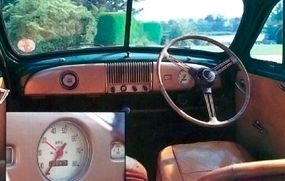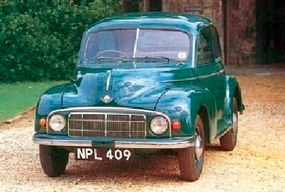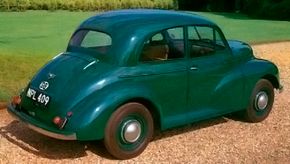William R. Morris (later Lord Nuffield) entered the car business in 1913. Early on he saw the need for low-priced private transportation -- only a few years after his American counterpart, Henry Ford. Built in Oxford, England, Morris' first car featured a tiny one-liter four. Morris remained an independent producer of low-priced cars through the prewar years, building 54,000 in 1925 and capturing 51 percent of the British market. The new-for-1935 Series I Eight, with 22.5-bhp and a three-speed gearbox, was Britain's best selling car of the 1930s.
Advertisement
In 1939, the Series E Eight bowed. Looking much like a shrunken Chrysler Airflow, it featured an 89-inch chassis and a four-speed transmission. Though produced after the war, it was replaced by the Series MM Minor, which debuted at the Earls Court Auto Show in late 1948. Code-named "Mosquito" during its gestation, it was Morris' first genuine postwar car -- and a breath of fresh air. It combined an American-style envelope body with state-of-the-art engineering by Alec Issigonis and Jack Daniels: lightweight unit body/chassis, torsion-bar independent front suspension, hypoid rear axle, and rack-and-pinion steering.

The Minor's 86-inch wheelbase was three inches shorter than the Eight's (8.5 less than the VW Beetle). Yet the MM was four inches longer, and equally spacious inside. It was accorded high acclaim; Britain's The Motor magazine affirmed with characteristic phlegm that it was "a very good 8-hp car indeed."
The "8-hp" referred to the old Royal Automobile Club rating for taxable horsepower, and also to the old 918.6-cc sidevalve four. Taken from the Eight, it produced 27.5 net bhp at 4400 rpm. That wasn't a lot: 0-50 mph took no less than 24 seconds of hard shifter-flogging and top speed was only about 65 mph.
The late Michael Sedgwick wrote that "the aged 8-hp unit looked out of place in these sophisticated surroundings. Even a good Fiat Topolino could beat a Minor to 30 mph. Handling, however, set new standards . . . . " The Minor returned 40 miles to the Imperial gallon (30 + U.S.) -- and in petrol-short postwar Britain this was important.

Over the years, the Minor would receive more powerful engines and more body styles: initially two-door sedan and Tourer (convertible), four-door sedan in 1951, woody Traveller wagon in 1954.
The 500,000th Minor was built in 1957, the millionth in 1961 -- the Minor being the first British car to achieve that lofty level. The last one left the factory in October 1970: car number 1,582,302.
The Romaine Green 1950 Morris Minor two-door seen here belongs to the National Motor Museum in Beaulieu, Hampshire, England. Notably, it was the last of the Minors with headlights mounted in the grille; for 1951 they migrated up into the fenders to meet the height requirements of various export markets, the U.S. included. The Minor can be thought of as England's postwar "people's car," and is a "cult" collectible there now. That's because, as auto historian Richard M. Langworth has stated, "the Morris Minor was a car of great character and distinction, and it will be remembered."
For more information on cars, see:
- Classic Cars
- Muscle Cars
- Sports Cars
- Consumer Guide New Car Search
- Consumer Guide Used Car Search
Advertisement
